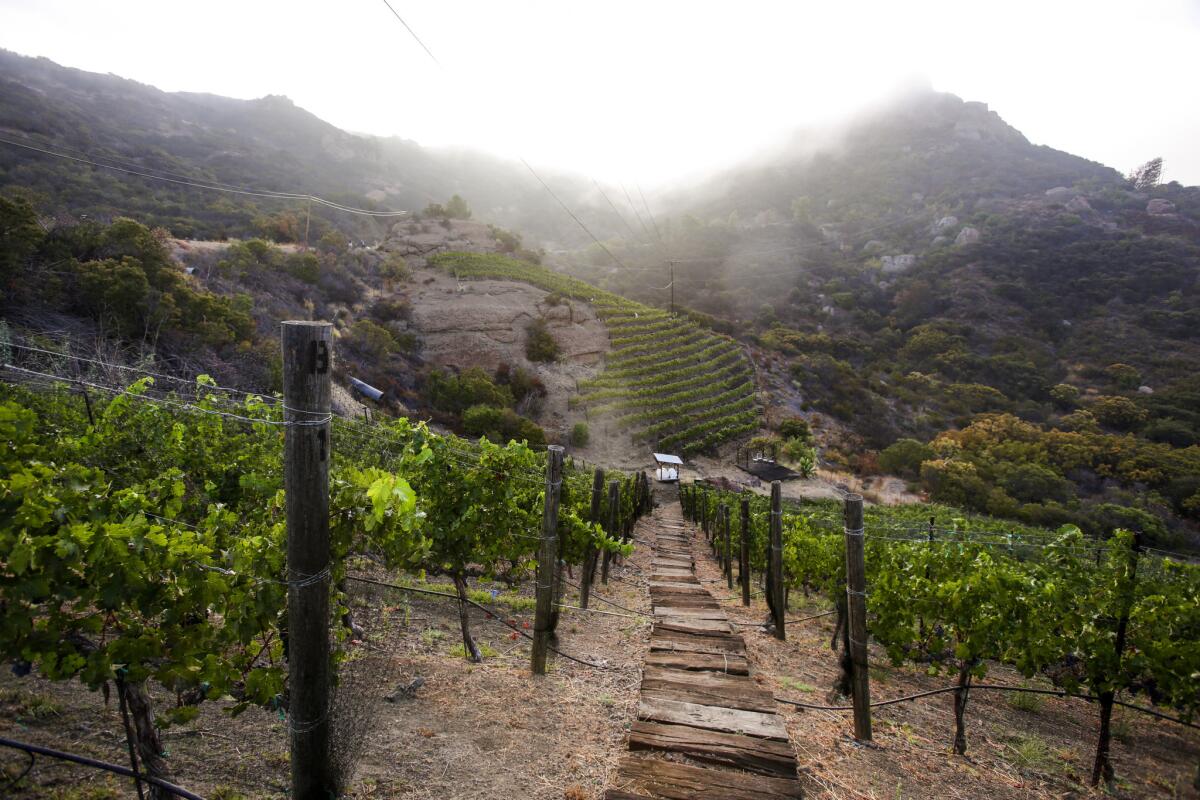Landowners fight ban on new vineyards in Santa Monica Mountains area

A view of a vineyard owned by Ruth and David Gomez in Malibu on August 23, 2014.
- Share via
Malibu vintners and grape growers will try Tuesday to persuade the Los Angeles County Board of Supervisors to lift a temporary ban on new vineyards, or extensions of existing ones, in the north Santa Monica Mountains.
The ban was imposed last month when supervisors saw an increase in new vineyard applications just as residents in other parts of the county were being asked to cut back water use because of the statewide drought.
County officials have received 51 applications for new vineyards in the last 10 months, whereas the previous year generated three. The mountain area includes unincorporated Malibu, Agoura, parts of Calabasas and Topanga.
“The number of applications for new vineyards worried me in the aggregate because of the overall amount of additional water that could be drawn down, as well as there being no information about what chemicals or pesticides might be added to runoff,” Supervisor Sheila Kuehl said. “These were not just half an acre or small backyard vintners, but applicants for larger vineyards. People just drill wells. They draw water.”
Kuehl said a study found that in vineyard-rich Central California, the water table had been lowered significantly. “And in the mountains, we don’t have a way to measure the impact of vineyards drawing off water upstream.”
Dan Fredman, owner of a small backyard vineyard and a spokesman for the Malibu Coast Vintners & Grape Growers Alliance, said, “When we saw the proposed measure, we were down at the planning commission offices as quickly as we could, to provide them with correct information on grapevines and viticulture as it’s practiced in Malibu.”
Vine growers believe the moratorium is unnecessary because they’ve already begun working with the county’s Department of Regional Planning to address concerns about vineyards in the area.
Some landowners applied for vineyards for their entire property and may have only planted on a small portion of their land.
When the grape growers alliance investigated, it found that all those applications had been made as the result of a meeting with planning commission representatives a year ago, during which property owners in the Triunfo/Lobo area were advised to get in their applications if they were even thinking about planting a vineyard in the future. They took the advice to heart, fearing they’d be shut out in the future unless they had a permit for a vineyard grandfathered in.
“The real hardship is directed at the landowners who have already submitted applications for vineyard permits and are legally entitled to plant crops on their agriculturally zoned land,” said Montage Vineyards’ John Gooden, president of the Malibu Coast Vintners & Grape Growers Alliance.
“All these people were trying to do was comply with the law and they went ahead and hired land use consultants, had maps drawn, etc. This ordinance is discriminating against grapes. They’re not banning avocado orchards, and they use seven times the amount of water that grapevines do.”
Malibu is not and never was poised to become the next Napa Valley. With the exception of vineyards in the Kanan/Mulholland area, plots are small. Most are farmed sustainably by the families themselves. Vines are drought-tolerant. In fact, the plants produce better fruit when they’re stressed.
Vineyards in Malibu are watered, if at all, by drip irrigation. That means there’s no runoff, the vintners argue, and the water goes to the plant’s roots.
“The members of the alliance have become absolute misers in terms of our water use,” Fredman said. “We farm sustainably and with acute attention to the beauty of our natural surroundings.”
The Malibu Coast Vintners and Grape Growers Alliance also contends that the figures cited by the supervisors were incorrect. Several properties applying for new permits had been assigned multiple permit numbers, and in many cases the entire acreage had been counted rather than just the portion under vines.
“In the big scheme of things, we’re talking about an insignificant amount of acreage. The north area encompasses 21,188 acres, and the acreage under consideration is not even 2% of that, so would not have an impact on the environment,” Gooden said.
“Vineyards should have a place in the land use plan,” he said. “They’ve been in the Santa Monica Mountains for over 200 years. We’re just trying to continue a tradition of sustainable family farming.”
Members of the alliance have been meeting individually with supervisors and planning staffers to explain their position and predicament.
They’re also encouraging people to go to the alliance’s website and sign a petition supporting vineyards in the Santa Monica Mountains and to attend the supervisors’ meeting at the downtown Los Angeles County Hall of Administration.
Follow @sirenevirbila for more on food and wine.
Also:
Metro’s dreary, dangerous Rosa Parks Station in Willowbrook to get a major makeover
L.A. County supervisors agree to boost minimum wage to $15 an hour by 2020
Supervisors vote to settle final Antelope Valley discrimination case
More to Read
Sign up for Essential California
The most important California stories and recommendations in your inbox every morning.
You may occasionally receive promotional content from the Los Angeles Times.










